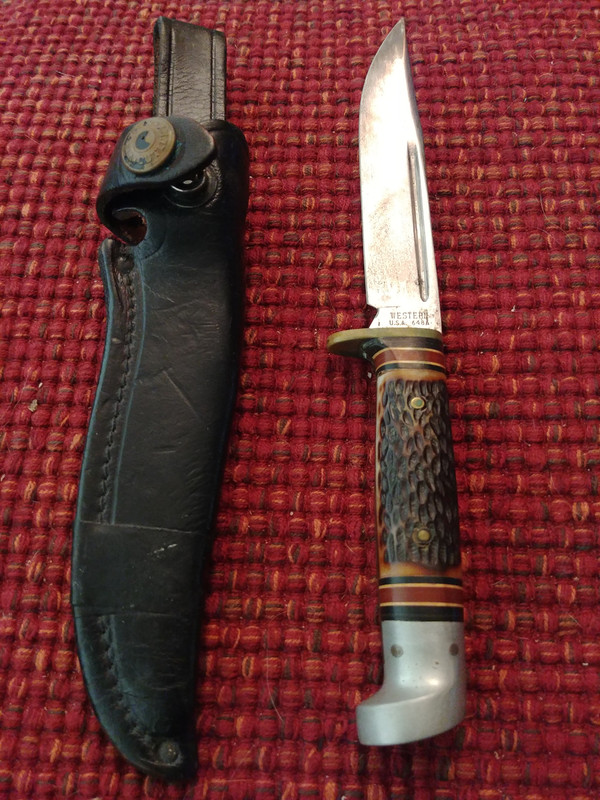Here is a long winded history of the 28/48 pattern knives by Western.
The 48 is in the 1931 catalog as a 248, X248 and L48. No 48A or 48B. These early ones were the fore runners of the 48A knives.
The 48 is still in the 1936 catalog, but the 248 is gone. Only the L48 and X248 are still present.
1941 had a ton of 48 patterns - the standard L48 and X248 are still there, the X248 returns and the 548, R48, 48BGH, 48BG and W48F make their debut. The 548 had a stag handle, W48F had a cocobola handle, the 48BGH and 48BG had orange, yellow or green tenite handles and were "Finnish" in construction - no guard on the edge side of the handle. The R48 has "red composite" handles and the guard "did not extend beyond the handle." I take that to mean "Finnish style".
1941 also saw the introduction of the 28 pattern in the form of the BG28. Yellow, orange and green tenite handles, guardless "Finnish" style WITHOUT a lanyard hole in the pommel.
During WW2, the 48 pattern essentially disappears and almost all civilian construction ceased. I have a W48 lying around somewhere that has a pre-WW2 stamp and a steel guard, IMPLYING that at least some civilian production occurred during the war.
We only have advertisements for the 1946 to 1949 era.
Over the years, I have found a 1947 ad for the 48BGG with "brilliant orange, bright green, rich ivory and sunset red tenite handles", 1947 and 1948 ads for the L48 and a 1948 Distributors catalog page that listed the L48A, the L48C, 48BAP, and 48CAP. A 1948 ad shows the 48CAP advertised as the "No. 28" with red/ivory/orange plastic, leather or bone stag handles.
The L48C and 48CAP had 2-1/2" blades, making them close equivalents of the 28 pattern. The 48BAP is the first instance of what would later become the 48B pattern. There were NO pictures of the L48C or 48CAP in the catalog, so I don't know if the 1948 versions had a lanyard hole.
The 1950 catalog shows a plethora of 48 and 28 patterns. The first group is the 48BGG, 48BAP and 48CAP. Red, ivory or orange plastic handles. In this grouping is also the 28AP, available with red or ivory handles and a lanyard hole.
Also in the 1950 catalog is the L48ABG, L48B, L28 (with lanyard hole) and the No.84 Combination, which was a double sheath for the 48BGG and 48CAP, also with red, orange or ivory handles. I have seen combos for sale with all Ivory, all Red and red/ivory mixed handles.
1954/1955 saw the introduction of model numbers to the pile side ricasso. As I have never seen a pile side model number of 48BGG or 48BAP or 48CAP, I have assumed that this is about the time these models changed to P48A, P48B and P28.
In 1956, we saw the introduction of the Black Beauty set of knives. This set included the F48A, F48B and F28.
The 1959-1960 catalog had the L48A, 648 (bone stag), 248, P48A, L48B and 648B (bone stag) in the 48 patterns. I have been unable to determine WHEN the L48ABG became the L48A. The L48A retained the fuller of the L48ABG, but the BG was dropped.
The 29 pattern for 1959-1960 had the L28, 648, and P28 (ivory and red tenite), with lanyard holes.
There was also the "Twin Sets" - L84, P84 and 684, with leather, tenite or bone stag handles.
Starting in 1961, any of the 648, 648B knives would have had Delrin "bone stag" handles instead of real bone stag.
The next set of known changes in in 1967/1968. Model numbers shifted from the pile side ricasso to the guard. This catalog had the L28 and F28, the L48B, F48B and 648B, L48A, 648, F48A, and the S-648B and S-648 with stainless steel blades.
By 1975, the 48 pattern is down to the 648A, 648B and F48B, and the 28 pattern is down to the 628. All these 6xx knives had Delrin handles. The 1975 pamphlet does not show enough detail to determine if the 628 still has a lanyard hole.
The 1980 catalog shows the 628 without a lanyard hole. The 628 and all 48 patterns have bone stag Delrin handles. No lanyard holes. 648A, 648B, S-H48A, S-H48B. The H48 series also has Delrin handles, but Western specified that these knives had "horn patterned Delrin" rather than "bone stag Delrin" handles.
By 1986, we are down to the 628 and L48. The L48 is L48A sized, but "A" and "B" designations have disappeared, probably due to the demise of the 48B family.
Sometime between 1986 and 1989, Coleman Western added the R16, a rubber handled B&T.
By 1991, the last "full year" of Longmont production, only the 628 is left of all the B&Ts Western had produced over the years.
In 1993, the first full year of Camillus production, we have the L628, which was a stupid designator, but for reasons beyond comprehension, Camillus took the 628, put leather disks on it and called it an "L628". Camillus continued the R16 Small hunter.
1996 showed the introduction of the R2 B&T , and R12 and R16 Small Hunter, along with L628.
Camillus continued to produce all these B&Ts/Small hunters through 2006, the last year of production.








